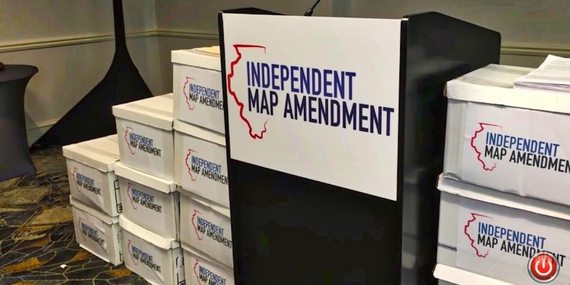The Illinois Supreme Court on Thursday closed the door on the Independent Map Amendment for the 2016 election, but not too tightly.
The ruling majority of justices in their decision singled out one problem with the proposed amendment that put it in violation of the state constitution. Fix that, the court said, and we'd give this another chance.
It has to do with two issues: First, the constitution says citizen-led initiatives like this one "shall be limited to structural and procedural subjects" of the General Assembly. Second, the Independent Map Amendment sought to set up an independent map-drawing commission in which the Illinois Auditor General -- who is not a member of the General Assembly -- would play a role.
"Independent Maps makes the policy argument that upholding the circuit court's finding that the plaintiffs were entitled to judgment on the pleadings will 'make it largely impossible to make meaningful reforms in the redistricting process.,'" writes Justice Thomas Kilbride, writing for the four Democrats on the court. "We respectfully disagree. The Auditor General is not the only potential nonlegislative actor capable of filling the duties outlined in its proposal."
Later, Kilbride writes, "Our decision is not intended to reflect in any way on the viability of other possible redistricting reform initiatives." (The full decision is here.)
Two years ago, the court was more explicit in ruling that term limits are not a subject that citizens can impose via a ballot proposal. (The court also had rejected a citizen-led term limits effort in 1994.) Thursday's decision hints that absent the auditor general in the process, redistricting reform might make it onto a general election ballot.
But given the tremendously arduous process necessary to get any ballot initiative before the court -- it starts with gathering a minimum of nearly 300,000 verifiable voter signatures -- another Independent Map-style effort for the 2018 election is anything but certain.
"The Supreme Court rules give us the opportunity to seek rehearing and our legal team is weighing that option," said Dennis FitzSimons, chairman of Independent Maps. But FitzSimons' statement did not indicate optimism. "...In short, the system is broken, and the way this Court interprets the Constitution seems likely to prevent its repair."
The Illinois General Assembly could place a redistricting reform amendment onto the 2018 with three-fifths majority votes in the House and Senate. Lawmakers are not restricted in what they can amend.
Gov. Bruce Rauner has spent the summer giving speeches that emphasize the heavy public support for redistricting reform and legislative term limits. He wants the General Assembly to act on both when it returns to Springfield a week after the November election.
But there is virtually no chance of either being taken up in the Legislature, where Democrats hold three-fifths majorities and where its most powerful member -- House Speaker Michael Madigan -- has been the state's most vocal and adamant opponent of both.
But Madigan is taking a gamble by fighting to preserve the current map-drawing system, in which Democrats have substantially boosted their power with maps they drew in 2001 and 2011.
Under the Illinois Constitution, new district maps following each U.S. Census are passed much bills in the General Assembly and signed into law by the governor. This is no problem when the House, Senate and governor's office all are controlled by a single party. But if there are two parties involved, it's a different story. If the House, Senate and governor can't agree on a map, the constitution calls for creation of an eight-member commission with four members of each party to hash it out.
If the commission can't agree, "Supreme Court shall submit the names of two persons, not of the same political party, to the Secretary of State (who) shall draw by random selection the name of one of the two persons to serve as the ninth member of the Commission," says the state constitution.
The luck-of-the-draw option was inserted in the 1970 constitution because the framers believed it would force compromise. They had faith that state leaders would never leave a decision as important as drawing district maps to an all-or-nothing gamble. Instead, the parties have opted three times to go for the luck of the draw. Democrats won in 1981 and 2001. Republicans won in 1991, and their map helped win them the majority in the House for the 89th General Assembly (January 1995-January 1997). Those were the only two years between 1983 and today that Michael Madigan was not Speaker of the House.
Should Rauner run for and win re-election in 2018 and the system remains as it is, Republicans will have a 50-50 shot at drawing the new map in 2021.

